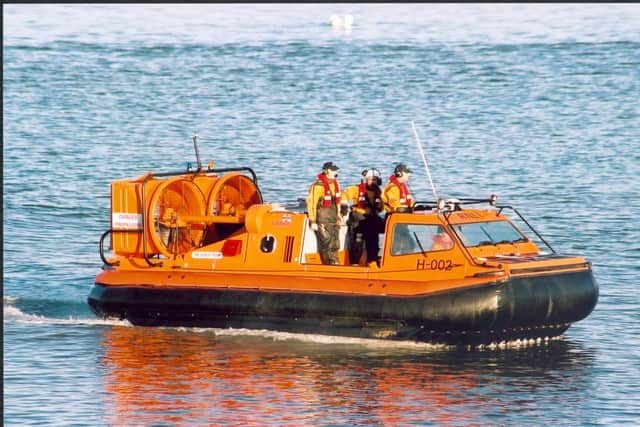Morecambe RNLI celebrate 20 years of inshore rescue hovercraft
and live on Freeview channel 276
The amphibious inshore rescue hovercraft has enabled the RNLI to carry out its lifesaving work in areas inaccessible to conventional lifeboats since 2002.
Designed for search and rescue purposes, the hovercraft can tackle incidents on tidal mudflats or sand where the surface is too soft to support land vehicles and where the water is too shallow for boats.
Advertisement
Hide AdAdvertisement
Hide AdThe IRH has extended Morecambe RNLI’s lifesaving capability around Morecambe Bay, having aided more than 200 people and saved 24 lives over the two decades. The hovercraft has been an invaluable asset for its volunteer crews in saving lives at sea.


Hurley Flyer, the first of the hovercraft fleet to become a station asset, was donated by Mrs Hurley from Oxfordshire and has been on service at Morecambe Lifeboat Station for 20 years.
The late Harry Roberts MBE paved the way for the hovercraft to go to Morecambe RNLI, as he was heavily involved in the initial building of the Griffon hovercraft and the trials within Morecambe Bay.
He went on to become the first volunteer Hovercraft Commander for the RNLI then Senior Hovercraft Commander at the station for several years.
Advertisement
Hide AdAdvertisement
Hide AdHarry’s daughter and press officer at Morecambe RNLI, Amy Roberts, said: "The hovercraft has had a huge lifesaving impact at Morecambe. My father always said that the hovercraft is “invaluable” to the community, as a lot of our rescues would be very difficult to execute in any other craft.
"I saw the first prototype of the Griffon hovercraft in Poole with my father when I was just 10 years old. It was still in the very early stages of development, but it was then that my father started to push for the hovercraft to be at Morecambe because he knew it would help save more lives around Morecambe Bay."
Harry was commander of the hovercraft the night of the Morecambe Bay cockling tragedy, which saw him flying the hovercraft for 22 hours. He was awarded an MBE in 2008 by the Queen for his services to maritime safety.
Steve Wilson, lifeboat operations manager at Morecambe, has been part of the RNLI for 27 years.
Advertisement
Hide AdAdvertisement
Hide AdHe said: "Harry was the driving force in Morecambe RNLI. He invested a huge amount of time on the development of the hovercraft to what’s on station today.
"Over his 34 years at the RNLI, Harry inspired and trained many volunteers and to this day, his work continues to inspire the current crew at the station. His legacy lives on through the hovercraft."
With large areas of mud, sand and shallow water, Morecambe RNLI requires the craft for its unique capabilities in reaching inaccessible areas, shoreline searches, and tackling dangerous terrain.
Steve said: "Having been part of the RNLI for almost three decades now, I have seen Morecambe Lifeboat Station with and without the hovercraft and I can safely say it has had a positive impact on the community.
Advertisement
Hide AdAdvertisement
Hide Ad"Having the hovercraft and lifeboat on station brings many benefits to our lifesaving work for example, if we’re looking for a missing person and we don’t know exactly where they are, we have both assets doing parallel searches – so the hovercraft can go along the shoreline and the lifeboat can be a mile further out searching the water. It expands our search capabilities a huge amount."
Morecambe RNLI have launched more than 450 times with the hovercraft since it went on service in 2002, with 20 of these launches involving animal rescues, including dogs, sheep and cattle.
Ross Simpson, senior hovercraft commander and mechanic at Morecambe RNLI, said: "The hovercraft is a big part of Morecambe’s community, there’s even a pub named after it! There’s only four RNLI stations with a hovercraft and we’re lucky enough to be one of them. It’s always been a privilege to be part of the hovercraft crew.
"The craft itself has made a huge difference to the efficiency and effectiveness of our 24/7 search and rescue service, enabling us to save even more lives around the coast."
Advertisement
Hide AdAdvertisement
Hide AdRoss will be involved in the future development of the hovercraft with the RNLI, following in the foot =steps of Harry Roberts.
He added: "It feels fantastic to be involved in the future plans of the hovercraft. Morecambe RNLI has had a long history with the hovercraft and it is a honour to be able to continue it."
To find out more about the RNLI’s hovercraft, visit RNLI.org/hovercraft
RNLI advice
*Check the weather forecast and tide times before visiting the coast.
Advertisement
Hide AdAdvertisement
Hide Ad*If you find yourself unexpectedly in the water, remember to FLOAT – fight the urge to thrash around, lean back, and extend your arms and legs.
*If you find yourself in an emergency or spot someone else in trouble, you should call 999 or 112 and ask for the Coastguard.
Key facts about the RNLI
The RNLI charity saves lives at sea. Its volunteers provide a 24-hour search and rescue service around the United Kingdom and Republic of Ireland coasts.
The RNLI operates more than 238 lifeboat stations in the UK and Ireland and, in a normal year, more than 240 lifeguard units on beaches around the UK and Channel Islands.
Advertisement
Hide AdAdvertisement
Hide AdThe charity currently operates seven hovercrafts out of four RNLI stations, including Morecambe, Hunstanton, Southend-on-Sea and Hoylake, with three part of its relief fleet.
The RNLI is independent of Coastguard and government and depends on voluntary donations and legacies to maintain its rescue service.
Since the RNLI was founded in 1824, its lifeboat crews and lifeguards have saved over 142,700 lives.